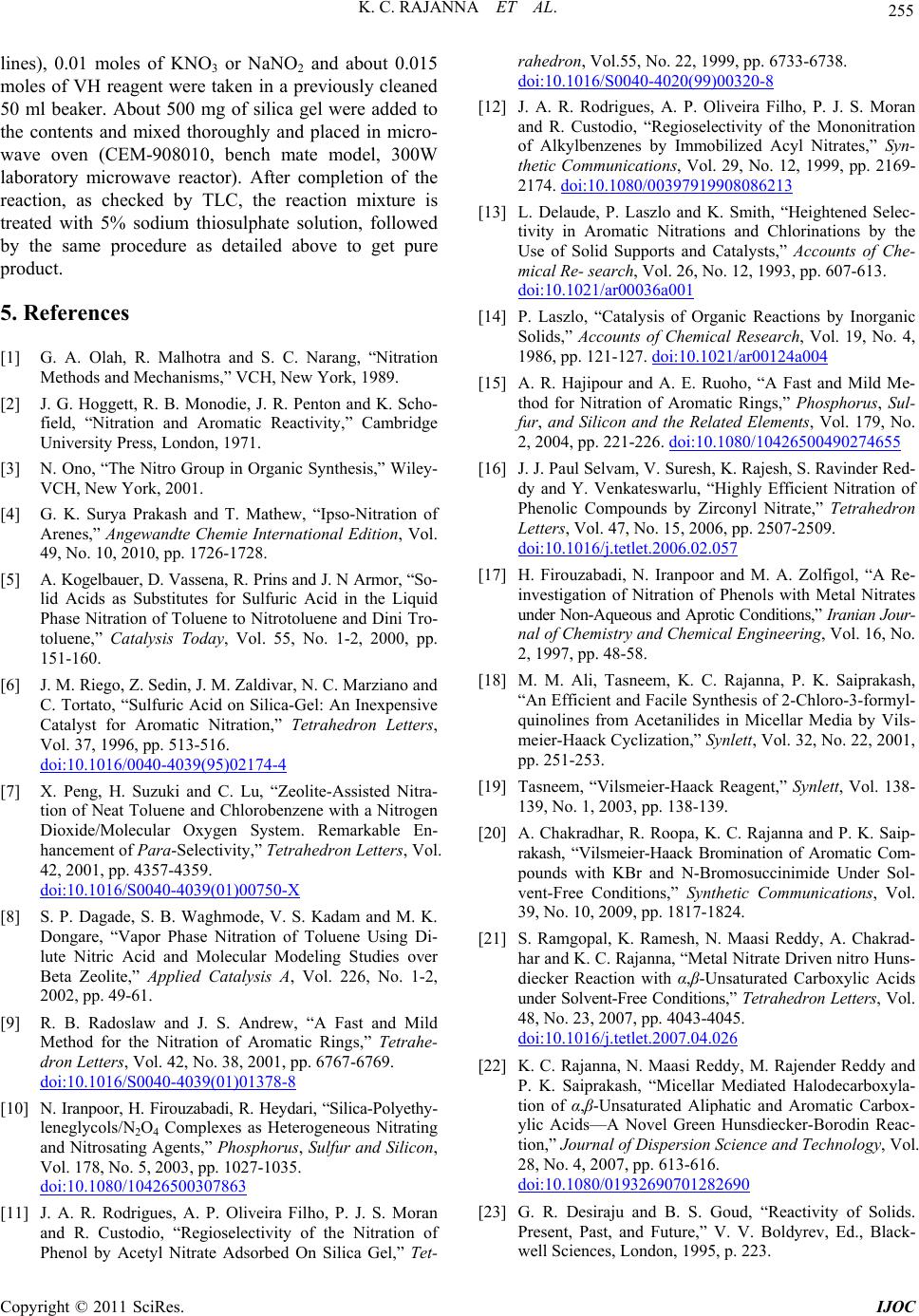
255
K. C. RAJANNA ET AL.
lines), 0.01 moles of KNO3 or NaNO2 and about 0.015
moles of VH reagent were taken in a previously cleaned
50 ml beaker. About 500 mg of silica gel were added to
the contents and mixed thoroughly and placed in micro-
wave oven (CEM-908010, bench mate model, 300W
laboratory microwave reactor). After completion of the
reaction, as checked by TLC, the reaction mixture is
treated with 5% sodium thiosulphate solution, followed
by the same procedure as detailed above to get pure
product.
5. References
[1] G. A. Olah, R. Malhotra and S. C. Narang, “Nitration
Methods and Mechanisms,” VCH, New York, 1989.
[2] J. G. Hoggett, R. B. Monodie, J. R. Penton and K. Scho-
field, “Nitration and Aromatic Reactivity,” Cambridge
University Press, London, 1971.
[3] N. Ono, “The Nitro Group in Organic Synthesis,” Wiley-
VCH, New York, 2001.
[4] G. K. Surya Prakash and T. Mathew, “Ipso-Nitration of
Arenes,” Angewandte Chemie International Edition, Vol.
49, No. 10, 2010, pp. 1726-1728.
[5] A. Kogelbauer, D. Va ssena, R. Prins a nd J. N Ar mor, “So-
lid Acids as Substitutes for Sulfuric Acid in the Liquid
Phase Nitration of Toluene to Nitrotoluene and Dini Tro-
toluene,” Catalysis Today, Vol. 55, No. 1-2, 2000, pp.
151-160.
[6] J. M. Riego, Z. Sedin, J. M. Zaldivar, N. C. Marzia no and
C. Tortato, “Sulfuric Acid on Silica-Gel: An Inexpensive
Catalyst for Aromatic Nitration,” Tetrahedron Letters,
Vol. 37, 1996, pp. 513-516.
doi:10.1016/0040-4039(95)02174-4
[7] X. Peng, H. Suzuki and C. Lu, “Zeolite-Assisted Nitra-
tion of Neat Toluene and Chlorobenzene with a Nitrogen
Dioxide/Molecular Oxygen System. Remarkable En-
hancement of Para-Selectivity,” Tetrahedron Letters, Vol.
42, 2001, pp. 4357-4359.
doi:10.1016/S0040-4039(01)00750-X
[8] S. P. Dagade, S. B. Waghmode, V. S. Kadam and M. K.
Dongare, “Vapor Phase Nitration of Toluene Using Di-
lute Nitric Acid and Molecular Modeling Studies over
Beta Zeolite,” Applied Catalysis A, Vol. 226, No. 1-2,
2002, pp. 49-61.
[9] R. B. Radoslaw and J. S. Andrew, “A Fast and Mild
Method for the Nitration of Aromatic Rings,” Tetrahe-
dron Letters, Vol. 42, No. 38, 2001, pp. 6767-6769.
doi:10.1016/S0040-4039(01)01378-8
[10] N. Iranpoor, H. Firouzabadi, R. Heydari, “Silica-Polyethy-
leneglycols/N2O4 Complexes as Heterogeneous Nitrating
and Nitrosating Agents,” Phosphorus, Sulfur and Silicon,
Vol. 178, No. 5, 2003, pp. 1027-1035.
doi:10.1080/10426500307863
[11] J. A. R. Rodrigues, A. P. Oliveira Filho, P. J. S. Moran
and R. Custodio, “Regioselectivity of the Nitration of
Phenol by Acetyl Nitrate Adsorbed On Silica Gel,” Tet-
rahedron, Vol.55, No. 22, 1999, pp. 6733-6738.
doi:10.1016/S0040-4020(99)00320-8
[12] J. A. R. Rodrigues, A. P. Oliveira Filho, P. J. S. Moran
and R. Custodio, “Regioselectivity of the Mononitration
of Alkylbenzenes by Immobilized Acyl Nitrates,” Syn-
thetic Communications, Vol. 29, No. 12, 1999, pp. 2169-
2174. doi:10.1080/00397919908086213
[13] L. Delaude, P. Laszlo and K. Smith, “Heightened Selec-
tivity in Aromatic Nitrations and Chlorinations by the
Use of Solid Supports and Catalysts,” Accounts of Che-
mical Re- search, Vol. 26, No. 12, 1993, pp. 607-613.
doi:10.1021/ar00036a001
[14] P. Laszlo, “Catalysis of Organic Reactions by Inorganic
Solids,” Accounts of Chemical Research, Vol. 19, No. 4,
1986, pp. 121-127. doi:10.1021/ar00124a004
[15] A. R. Hajipour and A. E. Ruoho, “A Fast and Mild Me-
thod for Nitration of Aromatic Rings,” Phosphorus, Sul-
fur, and Silicon and the Related Elements, Vol. 179, No.
2, 2004, pp. 221-226. doi:10.1080/10426500490274655
[16] J. J. Paul Selvam, V. Suresh, K. Rajesh, S. Ravinder Red-
dy and Y. Venkateswarlu, “Highly Efficient Nitration of
Phenolic Compounds by Zirconyl Nitrate,” Tetrahedron
Letters, Vol. 47, No. 15, 2006, pp. 2507-2509.
doi:10.1016/j.tetlet.2006.02.057
[17] H. Firouzabadi, N. Iranpoor and M. A. Zolfigol, “A Re-
investigation of Nitration of Phenols with Metal Nitrates
under Non-Aqueous and Aprotic Conditions,” Iranian Jour-
nal of Chemistry and Chemical Engineering, Vol. 16, No.
2, 1997, pp. 48-58.
[18] M. M. Ali, Tasneem, K. C. Rajanna, P. K. Saiprakash,
“An Efficient and Facile Synthesis of 2-Chloro-3-formyl-
quinolines from Acetanilides in Micellar Media by Vils-
meier-Haack Cyclization,” Synlett, Vol. 32, No. 22, 2001,
pp. 251-253.
[19] Tasneem, “Vilsmeier-Haack Reagent,” Synlett, Vol. 138-
139, No. 1, 2003, pp. 138-139.
[20] A. Chakradhar, R. Roopa, K. C. Rajanna and P. K. Saip-
rakash, “Vilsmeier-Haack Bromination of Aromatic Com-
pounds with KBr and N-Bromosuccinimide Under Sol-
vent-Free Conditions,” Synthetic Communications, Vol.
39, No. 10, 2009, pp. 1817-1824.
[21] S. Ramgopal, K. Ramesh, N. Maasi Reddy, A. Chakrad-
har and K. C. Rajanna, “Metal Nitrate Driven nitro Huns-
diecker Reaction with α,β-Unsaturated Carboxylic Acids
under Solvent-Free Conditions,” Tetrahedron Letters, Vol.
48, No. 23, 2007, pp. 4043-4045.
doi:10.1016/j.tetlet.2007.04.026
[22] K. C. Rajanna, N. Maasi Reddy, M. Rajender Reddy and
P. K. Saiprakash, “Micellar Mediated Halodecarboxyla-
tion of α,β-Unsaturated Aliphatic and Aromatic Carbox-
ylic Acids—A Novel Green Hunsdiecker-Borodin Reac-
tion,” Journal of Dispersion Science and Technology, Vol.
28, No. 4, 2007, pp. 613-616.
doi:10.1080/01932690701282690
[23] G. R. Desiraju and B. S. Goud, “Reactivity of Solids.
Present, Past, and Future,” V. V. Boldyrev, Ed., Black-
well Sciences, London, 1995, p. 223.
Copyright © 2011 SciRes. IJOC